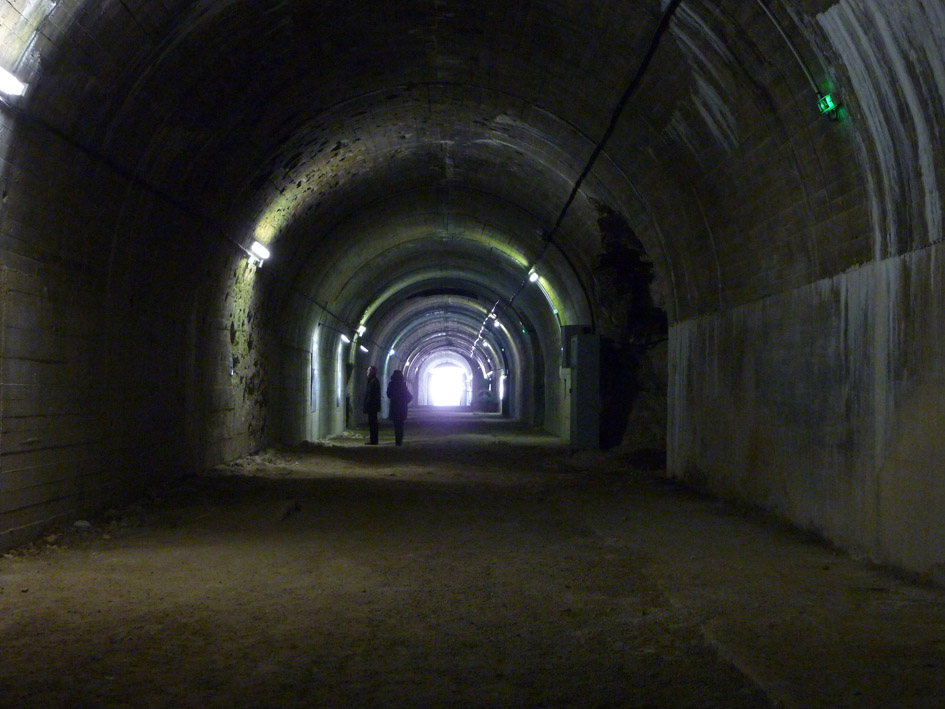Between June 1944 and March 1945, Hitler’s V1 and V2 rockets hit London. But there was a third weapon being developed, the V3, in the secret Mimoyecques fortress in Pas-de-Calais.
There isn’t a whole lot to see at Mimoyecques, but it is an odd, disturbing place and completes the story of the Vengeance weapons Hitler developed. And who do you know has seen it?
Visiting the secret Mimoyecques Fortress, the base of the London gun
The site is tucked away in the countryside near the north France coast and there’s little to tell you that this was one of the major sites for Hitler’s rockets aimed at the heart of London. There’s a small building at the entrance where you get your ticket and the story of the site, well worth a read.

You walk down into a huge tunnel that stretches ahead of you into the distant gloom. It’s dank, cold and dusty with flickering lights and panels on the walls telling more about the place. Tunnels lead off to right and left, some of which you can walk down.

At the end there’s a small exhibition about the Canadian 3rd Infantry Division which finally took over the site on September 5, 1944.

The Canadians landed on Juno Beach in Normandy as part of D-Day Landing operation.

An unexpected hero

In August 1944 an Allied raid was sent from England to bomb the Fortress. There’s one more twist in the tale. Joseph Patrick Kennedy Jr., (1915-1944) was the eldest son of Joseph P. Kennedy Sr. (1888-1969) and Rose Fitzgerald Kennedy (1890-1995) and older brother to President John F. Kennedy (1917-1963). By 1943 Lieutenant Kennedy was flying with the British Naval Command in a B-24. He volunteered for the bombing campaign to Mimoyecques, code named Operation Aphrodite. He flew from Suffolk on August 12, 1944 but never reached France. The explosives in his plane detonated prematurely on the flight and he died age 29.

It’s an eerie place, made even stranger by the fact that this is a bat sanctuary which means that it has limited opening times.
History of the V3 Gun
From 1943 to 1944, Hitler used the north of France as the location for building the V1 flying bombs and V2 rockets, the German’s Vengeance weapons. The blockhouse at Eperlecques was followed by the vast firing site of La Coupole.
At the same time the Nazi Reich, failing on the Eastern front, was developing the V3 in the secret Mimoyecques fortress, which, had it been successful would have been the ‘most devastating attack of all’, according to Winston Churchill.
The V3 gun

The ‘multi-charge gun’ was an extraordinary concept. The idea was to increase the range by increasing the speed of the shell which would be fired from an extremely long barrel. This was to be achieved by constructing multiple secondary propellant charges along the length of the barrel. As the shell shot through the barrel, the secondary charges would fire immediately after the shell had passed them, giving great impetus and speed.
It was an ambitious plan, aiming to produce 50 such guns, firing 2.5 rounds an hour. This, the Germans calculated, would mean 3,000 rounds carrying 90 tonnes of explosive striking London within the 93 mile (150 kilometer) radius.
It may have sounded terrifying but in reality it was impossible to achieve, particularly in the very short time span the German Minister of Armaments, Albert Speer, had allowed for the development and building.
Operation Todt was responsible for building the multi-charge gun firing site. Just 8 kilometers from the coast, so back from the danger of the Royal Navy bombardments, the secret Mimoyecques fortress was 165 kilometers from London. The first workers arrived in June 1943. It was a huge task, needing between 1,200 and 1,500 men building galleries below ground to house the gun shaft and the side galleries for the secondary firing. By September 1943 the first tunnels were built.

The British War Office was aware of the activity in north France. Using information gathered by the French Resistance and RAF reconnaissance aircraft, they identified the area and began Operation Crossbow (the codename for the Allied offensive against all the German weapon-firing bunkers).
From December 1943, the site was targeted. They might have devastated the surrounding area but much of the work was underground and this remained safe.
On July 5, 1944, the British learnt of three planned firings from the Mimoyecques site, aimed right at the heart of London. On July 6, two squadrons attacked. 100 Halifax planes carpet bombed the area. In the afternoon 16 Lancasters of the elite 617 Squadron, led by Wing Commander Leonard Cheshire, released 16 Tallboy bombs, designed by Barnes Wallis. It was decisive, destroying enough of the underground passages to stop the building. On July 16 1944, the labour force was evacuated.
Forteresse de Mimoyecques
Landrethun-le-Nord
Pas-de-Calais
Tel: +33 (0)3 21 87 10 34
Website
Open April to October daily 10am-6pm
Admission Adult €5.50 euros, 6 to 16 years €4 euros, under 6 years free
How to get there From Calais it’s a 20 minute drive. Take the A16 to exit 38 towards Saint Ingalvert/Wissant/Cap Gris-Nez. At Saint Ingalvert take the Route du Bois de l’Abbaye to the destination. It’s on the D29 between Landrethun-le-Nord and Leubringhen
To complete the trio of Hitler’s weaponry, visit La Coupole, and the Blockhouse at Eperlecques.

